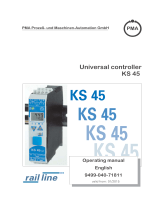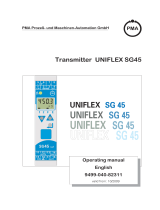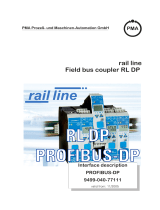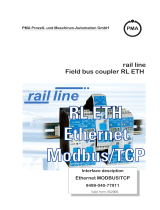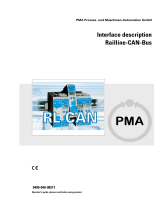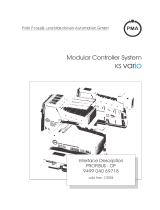Page is loading ...

BlueControl Poultry
Climate
User Manual
611821 • 2024-01-05 Software version 8.3


BlueControl Poultry
User Manual 3
Product and Documentation Changes
SKOV A/S reserves the right to change this document and the product herein described without further notice.
In case of doubt, please contact SKOV A/S.
The date of change appears from the front and back pages.
IMPORTANT
Notes concerning alarm systems
Breakdowns, malfunctions or faulty settings may cause substantial damage and financial losses when regulat-
ing and controlling the climate in a livestock house. It is therefore essential to install a separate, independent
alarm system that monitors the house climate concurrently with the climate and production controller. According
to EU-directive No. 98/58/EU, an alarm system must be installed in all mechanically ventilated houses.
We would like to draw your attention to the fact that the product liability clause of general terms and conditions
of sale and delivery specifies that an alarm system must be installed.
In case of an operating error or inappropriate use, ventilation systems can result in production
losses or cause loss of lives among livestock.
We recommend that ventilation systems should be mounted, operated and serviced only by
trained staff and that a separate emergency opening unit and an alarm system be installed as well
as maintained and tested at regular intervals, according to terms and conditions of sale and deliv-
ery.
Installation, servicing and troubleshooting of all electrical equipment must be carried out by quali-
fied personnel in compliance with the applicable national and international standard EN 60204-1
and any other EU standards that are applicable in Europe.
The installation of a power supply isolator is required for each motor and power supply to facilitate
voltage-free work on the electrical equipment. The power supply isolator is not included.
Note
• All rights belong to SKOV A/S. No part of this manual may be reproduced in any manner whatsoever without
the expressed written permission of SKOV A/S in each case.
• All reasonable efforts have been made to ensure the accuracy of the information contained in this manual.
Should any mistakes or imprecise information occur in spite of this, SKOV A/S would appreciate being noti-
fied thereof.
• Irrespective of the above, SKOV A/S shall not accept any liability with regard to loss or damage caused or
alleged to be caused by reliance on any information contained herein.
• Copyright by SKOV A/S.

BlueControl Poultry
User Manual
1 Guidelines ....................................................................................................................................................... 7
2 Product description ....................................................................................................................................... 8
3 Operating instructions................................................................................................................................. 11
3.1 Operation .................................................................................................................................. 11
3.1.1 Selection of language ................................................................................................................ 12
3.1.2 Information card ......................................................................................................................... 12
3.1.3 Search in menus ........................................................................................................................ 12
3.2 Operation – for broilers..................................................................................................... 14
3.3 Report ................................................................................................................................. 15
3.4 Auxiliary.............................................................................................................................. 16
3.5 Activity log ......................................................................................................................... 17
3.6 Menu button ...................................................................................................................... 18
3.6.1 Between batches - In-between functions ............................................................................ 19
3.6.2 Strategy ............................................................................................................................... 21
3.6.2.1 Setting curves ............................................................................................................................ 21
3.6.3 Settings................................................................................................................................ 22
3.6.3.1 System ....................................................................................................................................... 22
3.6.3.1.1 Password ................................................................................................................................... 22
3.6.3.2 Alarms........................................................................................................................................ 24
3.6.3.2.1 Stopping an alarm signal ........................................................................................................... 25
3.6.3.2.2 Power failure alarm .................................................................................................................... 25
3.6.3.2.3 Alarm test................................................................................................................................... 25
3.6.3.3 About.......................................................................................................................................... 25
4 Climate .......................................................................................................................................................... 26
4.1 Automatic climate control....................................................................................................... 26
4.2 Temperature ............................................................................................................................. 27
4.2.1 Temperature adjustment............................................................................................................ 27
4.2.1.1 Two-zone control ....................................................................................................................... 28
4.2.1.2 Heat wave comfort ..................................................................................................................... 29
4.2.1.3 Comfort temperature.................................................................................................................. 30
4.2.1.3.1 Advanced Comfort ..................................................................................................................... 31
4.2.1.4 Day and night adjustment .......................................................................................................... 31
4.3 Humidity.................................................................................................................................... 33
4.3.1 Humidification ............................................................................................................................ 35
4.3.2 Humidity control mode ............................................................................................................... 35
4.3.2.1 Humidity ventilation.................................................................................................................... 36
4.3.2.2 Temperature reduction............................................................................................................... 36
4.3.2.3 Humidity heat ............................................................................................................................. 37
4.3.3 Intelligent humidity control - at high outside temperature and outside humidity ........................ 37
4.3.4 Humidity settings........................................................................................................................ 38
4.3.4.1 Adaptive humidity ventilation ..................................................................................................... 38
4.3.4.2 Adaptive humidity heat............................................................................................................... 38
4.4 Ventilation................................................................................................................................. 40
4.4.1 Air quality ................................................................................................................................... 40
4.4.1.1 Cycle timer at minimum ventilation ............................................................................................ 42
4.4.1.2 NH3............................................................................................................................................ 42
4.4.1.3 Ventilation boost ........................................................................................................................ 43
4.4.2 Side ventilation........................................................................................................................... 45
4.4.2.1 Ventilation settings..................................................................................................................... 45
4.4.2.1.1 Zone controlled inlet................................................................................................................... 46
4.4.2.1.2 Inlet de-ice ................................................................................................................................. 46
4.4.2.1.3 Heat recovery unit...................................................................................................................... 47

BlueControl Poultry
4.4.3 Tunnel ventilation....................................................................................................................... 49
4.4.3.1 Cycle timer at tunnel ventilation ................................................................................................. 50
4.4.3.2 Chill factor and chill effect .......................................................................................................... 51
4.4.4 Combi-Tunnel ventilation ........................................................................................................... 52
4.4.4.1 Combi-tunnel ventilation: change between side and tunnel....................................................... 53
4.4.5 Soft chill ..................................................................................................................................... 53
4.4.5.1 Settings at Soft Chill ventilation ................................................................................................. 54
4.4.5.1.1 Ventilation .................................................................................................................................. 54
4.4.5.1.2 Temperature .............................................................................................................................. 55
4.4.5.1.3 Comfort temperature.................................................................................................................. 55
4.4.5.1.4 Setting of side cooling................................................................................................................ 55
4.4.5.1.5 Stir fan........................................................................................................................................ 56
4.4.5.1.6 In-between function.................................................................................................................... 56
4.4.5.1.7 Catching..................................................................................................................................... 57
4.4.6 FreeRange ................................................................................................................................. 57
4.4.6.1 Pop holes ................................................................................................................................... 59
4.4.6.2 Winter garden ............................................................................................................................ 59
4.4.6.3 Weather station.......................................................................................................................... 60
4.4.7 Natural ventilation ...................................................................................................................... 61
4.4.7.1 Pure natural ventilation .............................................................................................................. 62
4.4.7.2 Natural ventilation combined with mechanical ventilation.......................................................... 64
4.4.7.3 Natural ventilation using CO2 sensor ........................................................................................ 66
4.4.7.4 Natural ventilation using weather station ................................................................................... 66
4.4.8 Pressure..................................................................................................................................... 67
4.4.9 Ventilation status........................................................................................................................ 67
4.4.10 Parking of fans ........................................................................................................................... 68
4.4.11 Stir fan........................................................................................................................................ 69
4.4.11.1 Regulation via 24-hour clock...................................................................................................... 69
4.4.11.2 Regulation via temperature........................................................................................................ 70
4.4.11.3 Regulation via heat source ........................................................................................................ 72
4.4.12 Weather station.......................................................................................................................... 74
4.5 Cooling...................................................................................................................................... 75
4.5.1 Cooling potential ........................................................................................................................ 75
4.5.2 Side cooling ............................................................................................................................... 75
4.5.2.1 Start cooling ............................................................................................................................... 76
4.5.2.1.1 Side cooling start based on ventilation level .............................................................................. 76
4.5.2.2 Nozzle cleaning.......................................................................................................................... 78
4.5.3 Precooling .................................................................................................................................. 79
4.5.4 Tunnel cooling............................................................................................................................ 79
4.5.4.1 Tunnel cooling settings .............................................................................................................. 80
4.5.4.2 Start cooling ............................................................................................................................... 80
4.5.4.2.1 Tunnel cooling start based on a fixed air speed ........................................................................ 80
4.5.4.2.2 Tunnel cooling start based on an adapted air speed ................................................................. 81
4.5.4.2.3 Tunnel cooling start based on inside temperature ..................................................................... 82
4.5.4.3 Pad rinsing ................................................................................................................................. 82
4.6 Heating...................................................................................................................................... 83
4.6.1 House heaters............................................................................................................................ 83
4.6.1.1 Minimum heating........................................................................................................................ 84
4.6.2 Stand-alone heating................................................................................................................... 85
4.6.3 Floor heating .............................................................................................................................. 85
4.7 Catching.................................................................................................................................... 88
4.8 House status Active house - Empty house ........................................................................... 90
4.9 Between batches...................................................................................................................... 91
4.9.1 Soaking ...................................................................................................................................... 91
4.9.2 Washing ..................................................................................................................................... 92
4.9.3 Disinfection ................................................................................................................................ 92
4.9.4 Drying......................................................................................................................................... 93
4.9.5 Empty house .............................................................................................................................. 94
4.9.5.1 Preheating.................................................................................................................................. 94
4.9.5.2 Temperature surveillance .......................................................................................................... 95
User Manual

BlueControl Poultry
User Manual
5 Alarm settings .............................................................................................................................................. 96
5.1 Climate ...................................................................................................................................... 96
5.1.1 Temperature alarms................................................................................................................... 96
5.1.2 Humidity alarm ........................................................................................................................... 98
5.1.3 Inlet and outlet alarm ................................................................................................................. 98
5.1.4 Sensor alarm.............................................................................................................................. 99
5.1.5 Tunnel cooling sensor alarm...................................................................................................... 99
5.1.6 Pressure sensor......................................................................................................................... 99
5.1.7 CO2 alarm................................................................................................................................ 100
5.1.8 NH3 alarm................................................................................................................................ 100
5.1.9 Weather station alarm.............................................................................................................. 100
5.1.10 Heat recovery alarm................................................................................................................. 100
5.1.11 Dynamic Air Alarm ................................................................................................................... 100
5.1.12 Alarm for pop holes.................................................................................................................. 101
5.1.13 Winter garden alarms............................................................................................................... 101
5.1.14 Emergency control ................................................................................................................... 101
5.1.14.1 Emergency opening ................................................................................................................. 101
5.1.14.2 Temperature-controlled emergency opening ........................................................................... 102
5.1.14.3 Emergency inlet ....................................................................................................................... 102
5.2 Auxiliary.................................................................................................................................. 102
5.2.1 Auxiliary sensor alarm.............................................................................................................. 102
5.2.2 Auxiliary alarms........................................................................................................................ 103
5.3 Master/Client alarms.............................................................................................................. 103
5.4 Equipment status................................................................................................................... 103
6 Maintenance instructions .......................................................................................................................... 105
6.1 Cleaning.................................................................................................................................. 105
6.2 Recycling/Disposal ................................................................................................................ 105

BlueControl Poultry
User Manual 7
1 Guidelines
This user manual deals with the daily operation of the controller. The manual provides fundamental knowledge
about the functions of the controller that is required to ensure optimum use of it.
The user manual describes the general operation of the controller and all climate functions. A description of pro-
duction functions can be found in the appurtenant user manual for production.
If a function is not used, e.g. 24-hour clock, it is not shown in the user menus of the controller. The manual may
therefore contain sections that are not relevant to the specific setup of your controller. See also Technical Man-
ual or contact service or your dealer, if required.

BlueControl Poultry
8 User Manual
2 Product description
BlueControl poultry is a series of one-house controllers specifically designed for poultry houses. The controller
series includes several variants. Each of them meets the different requirements for climate and production con-
trol in connection with the production forms and geographical climatic conditions.
BlueControl poultry is available in the following climate variants:
• LPV
• Tunnel
• Combi-Tunnel
• Natural
Furthermore, it has standard broiler production functionality.
If additional production functionality is desired, the following add-on production software for poultry is further-
more available:
• Broiler (broiler)
• Breeder (parent stock)
• Layer-L (layers)
• Layer-M (layers)
The controller is operated via a large touch display with graphical views of the ventilation status, icons and
curves, among other things. The pages shown in the display are adapted the different variants so that the most
relevant functions are easily accessible. A wide range of functions such as 24-hour clock, light, water meter, and
auxiliary sensor can be named by the user, so that they suit the individual house and the functions are easier to
recognize in menus and alarms.

BlueControl Poultry
User Manual 9
The controller has 6 main pages, which are adapted to poultry production and a menu page. The pages contain
selected functions and views relevant to the daily work.
The page Operation
The page Auxiliary
The page Activity log
The page Report The page Strategy
The page Between batches
The page Menu
Figure1: By selecting the different elements of the pages, there is furthermore access to underlying functions and data from
the front pages.
The page Operation
The page is the main page view where the functions that must be
used for daily operation are gathered.
The page Report
The page can be set up according the user's wishes to contain cards
with key values showing current data.
It can thus be used to collect values that must be read daily and col-
lect data to be reported.
The page Activity log
The page displays a log of all recorded alarms, operations of the con-
troller and events.

BlueControl Poultry
10 User Manual
Menu button
The button gives access to language selection and to a collection of
shortcuts to the various pages.
| The page Between batches
The page gives access to functions designed partly to facilitate the
activities you must carry out in the house to clean it and prepare it for
the next batch and partly to ensure the air change and temperature in
the house while it is empty.
| The page Strategy
The page gives access to determination of the desired production
strategy, which must be repeated from batch to batch.
These are, for example, program settings, references, and batch
curves.
| The page Settings
The page provides access to general settings and alarm limits.
The page Auxiliary
The page gives access to graphical displays of historical data from
various types of additional equipment (auxiliary sensors and energy
meters).
The page is only displayed if additional equipment is installed.

BlueControl Poultry
User Manual 11
3 Operating instructions
3.1 Operation
Each page is composed by different types of cards that provide information about the operation and quick ac-
cess to operation.
B
G
AEC D F
From the top bar of the page, there are shortcut buttons that allow you to switch between the main pages Oper-
ation (C), Report (D), Auxiliary (E) and Activity log (F).
AThe icon and name of the page.
BThe house name, time, and possibly week and day number.
CThe Operation page provides an overview and the ability to operate the functions most needed for
your daily work.
DThe Reports page shows the key values the user wants on the page.
EThe Auxiliary page displays the consumption figures and auxiliary equipment status (if installed).
FThe Activity log page displays active alarms and a complete log of operations, events, and alarms.
GThe menu button gives access to language selection (see section Selection of language [}12]) and
other pages: Between batches, Strategy, and Settings.
Navigation menus provide access to sub-menus.
The right arrow displays a sub-menu.
The left arrow in the upper left corner allows you to take one
step back in the menu.
Scroll
If the page is higher or wider than the display, you can scroll.
This is shown in the display as arrows or a scroll bar.
Scroll by pressing the arrows or letting your finger slide across
the display.

BlueControl Poultry
12 User Manual
3.1.1 Selection of language
Press the Menu button.
A dot indicates the selected language.
Press More if the requested language is not displayed.
Select the language from the list. Press Confirm.
Note that function names (such as 24-hour clocks, water me-
ters, and programs the user can name) are not translated into
the selected language.
The factory setting for the names is English.
3.1.2 Information card
The information card is meant to give the daily user a better understanding of how the controller is working right
now.
The information is available on pages with the icon .
Press to view more details.
The following is described for selected control areas:
• The current status.
• The reason for the current adjustment.
• What the next step in adjustment will be.
3.1.3 Search in menus
It is easy to search for the individual functions of the controller. There are search fields on the pages: Auxiliary,
Between batches, Strategy, and Settings.
A search across the pages is performed.

BlueControl Poultry
User Manual 13
Use the search field to the left to search in menus.
Enter at least 3 characters to search.
The result is shown below the search field. The path for the in-
dividual menus is also shown, for example, under Settings:
General | Alarms | Climate.
Press a search result to go directly to that menu.
Press the X in the search field to remove the search results
again.

BlueControl Poultry
14 User Manual
3.2 Operation – for broilers
The page has been adapted for broiler production. It contains views and settings relevant to the daily work of a
broiler house.
BA
K
IJ
H
L
E
C
F
D
G
M
N
AThe function button Stop batch/Start batch. See section House status Active house - Empty house
[}90].
BThe function button Catching function. The function is designed to alter the air change in the house in
connection with all or some animals leaving the house. See section Catching [}88].
CThe function button Inspection for manually activating the inspection light.
DThe function button Boost for manually activating boost. The function improves air quality by briefly in-
creasing ventilation. See section Ventilation boost [}43].
E Shortcut to the main page Operation.
FView of outside temperature and outside humidity.
GStatus display for the climate control and access to the ventilation equipment menus.
The card also provides a shortcut for manual control of the climate equipment. It is intended for situa-
tions where equipment must be stopped.
HView of the current inside temperature of the individual climate sensors.
ITemperature settings. See section Temperature.
JHumidity settings. See section Humidity [}33].
KThe ventilation functions CO2 and NH3. See section CO2 and NH3 [}42].
LView the key figures for animal weight, feed, and water consumption development during the last 2
days. In addition, the view of calculated mortality and the current number of animals and shortcuts for
recording the number of animals, the number of dead and moved animals.
The view also provides a shortcut to details with information and settings options.
MStatus view for silo content. The views provide a shortcut to recording of feed supplies and settings op-
tions for silo.
NStatus view for climate and production functions controlled by time programs. The view provide an
overview of all programs and appurtenant settings, and for status and settings for production equip-
ment.

BlueControl Poultry
User Manual 15
3.3 Report
The user can set up the page to include the key values that give the desired overview of climate and production
values.
C
D
A
B
AShortcut to the Reports page.
BCard with the key value. Each card can be set up to include up to 3 key values. Some key values can
also comprise a small graphical history view.
CThe page displays a series of cards with selected key values for, for example, history and current val-
ues.
DEdit button. Gives access to choose between the desired key values.
E
F
G
H
ETools for editing headlines or content on cards and moving or deleting cards.
First, press a tool and then make the desired change.
FColumn header.
Press to name.
GCard with the key value.
Press to change the key value and set up its view.
HTool for adding a new card in the column.
Press to add a card and select the desired key value.

BlueControl Poultry
16 User Manual
Cards with several key values
You can merge several cards to view up to 3 key values in one card.
If the values can be displayed as graphs, the graphs can also be shown in the card.
Press the editing tool .
Press on the key value to be changed.
Select Key value 2 and select the key value to be displayed.
Select Key value 3, if required and select the key value to be
displayed.
To the right a preview of the card is shown.
3.4 Auxiliary
The page provides access to recordings from different types of equipment (auxiliary sensors and energy me-
ters), which can be used for monitoring, as an example.
A
B
C
AShortcut to the page Auxiliary.
BThe Auxiliary sensors menu provides an overview of the controller recordings supplied by the auxiliary
sensors in a graphical view.
The auxiliary sensors do not influence the regulation.
The controller records the content of CO2, NH3, O2 in the air as well as humidity, pressure, and tem-
perature. You can also connect air velocity and wind direction sensors that can measure the wind di-
rection and wind velocity outside the house.
The values measured by each sensor are viewed in intervals of 24 hours to 2 months.
CThe menu Energy consumption shows the current consumption in W and total consumption in kWh.
The menu content depends on the type and the setup of the controller.

BlueControl Poultry
User Manual 17
3.5 Activity log
The page displays a log of all recorded alarms, operations, and events.
Alarm status colors:
• Red – hard active alarm
• Yellow – soft active alarm (warning)
• Gray – deactivated alarm
D
C
B
A
AShortcut to the page Activity log.
The icon for the Activity log indicates the number of active alarms as long as an alarm situation has not
ceased.
BEach line shows an activity.
Press the activity line to see details, such as when an alarm was activated and acknowledged. Also,
when a value/setting was changed.
Press Close to close the details screen again.
CFiltering options for the various types of activities:
All: shows all types
Alarm: shows alarms
Operation: shows the operation of the controller
Event: shows, for example, reset of the controller
DSearch the field for the activity log.
Enter at least 3 characters to search. It is also possible to combine filtering and search.
Several alarms often follow each other because one defective function also affects other functions. For instance,
a flap alarm can be followed by a temperature alarm as the controller cannot adjust the temperature correctly
with a defective flap. Thus, the previous alarms allow you to follow an alarming course back in time to detect the
error that caused the alarm.
See the description of alarms in the section Alarms [}24].

BlueControl Poultry
18 User Manual
3.6 Menu button
The menu button gives access to language selection and general settings pages.
A
B
DF
C
E
AMenu button
BDisplaying house name, day number, time, week number, if required, variant name, and software ver-
sion.
CSelect language. Access other languages under More.
Note that function names (such as 24-hour clocks, water meters), and programs the user can name
are not translated into the selected language. The factory setting for the names is English.
DShortcut to the page In-between batches.
The page is designed partly to facilitate the activities you must carry out in the house to clean it and
partly to ensure the air change and temperature in the house while it is empty.
EShortcut to the page Strategy.
The page provides access to the batch curves, which form the basis for controlling climate and produc-
tion functions. See also the section Setting curves [}21].
FShortcut to the page Settings.
The page provides access to the user settings for House info, Alarm settings, and Password. See the
sections System [}22], Alarms [}24], and Password [}22].
In addition, you have access to the technical menus used for setup and service. See the Technical
Manual.

BlueControl Poultry
User Manual 19
3.6.1 Between batches - In-between functions
The page gives access to functions designed partly to facilitate the activities you must carry out in the house to
clean it and partly to ensure the air change and temperature in the house while it is empty.
• Soaking
• Washing
• Disinfection
• Drying
• Empty
Status
The controller can only activate the functions when the house
status is Empty.
Empty house status is indicated at the top of the page by a col-
ored bar.
When the time of a function is up, the controller will again regu-
late according to the settings for Empty house.
Batch 1 Batch 2
Cleaning
Empty house
Empty house
In-between
functions
Active house
Animals stocked
In-between
functions
Active house
Animals stocked
Day 0
Heating
Management
Delivery
Cleaning
Heating
Figure2: Setup example of the Between batches function for batch production
Day no.
At
Empty house
Ventilation
Ventilation closed
Ventilation
Ventilation
Heating
Ventilation closed
Temperature control
Preheating
Ventilation shut off
Heater
Temperature surveillance
Soaking Washing DryingDisinfection
Figure3: Sequence of functions

BlueControl Poultry
20 User Manual
Program sequence
You can set up each function to start at a specified time. It is
thus possible to set an entire program sequence for the func-
tions.
Menu button | Between batches | Info | House mode | Program sequence
This house is: Function selection menu (only displayed when the house status is Empty).
Function remaining time When a function is activated, the set time counts down (only displayed when the
house status is Empty).
Program sequence Menu for setting the start time and function duration (only displayed when the house
status is Empty).
Also see the section Between batches [}91] for a description of the various functions.
/
